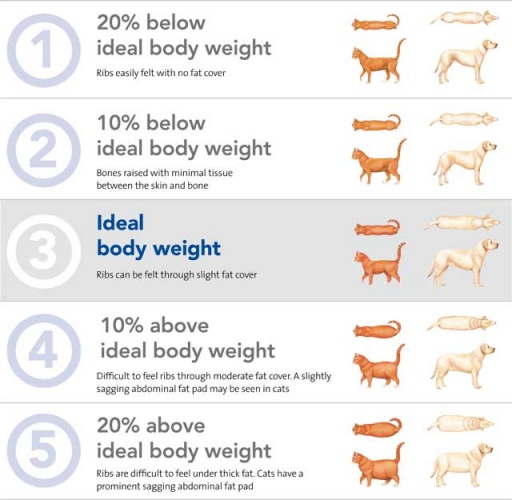Posted on 13 Jan 2014 in Dogs, Cats, Nutrition, Obesity
Overweight Pets
Obesity is a common problem in Australia, not only for people, but for dogs and cats too. Weight loss can be challenging, but losing weight and getting fit can add years to your pet's life, and make those years considerably more enjoyable.
Is your pet overweight?
It is not always easy to notice that your pet is starting to get overweight. Your vet will usually assess your pet's body condition each time they come in for a check-up, and they will let you know if your pet is above (or below) ideal body weight. Have a look at the table below for the signs that you can look for in your pet to see if they are overweight.:

If you think your pet is overweight, make an appointment to see one of our vets at All Pets Vet Hospital. If your vet determines that your pet is overweight, and that a weight-loss plan is appropriate, we can help! It is not easy to achieve and maintain weight-loss without support, and we can offer regular weigh-ins and advice. We can organise a free consultation with one of our nurses to get your pet started on the Hill's Petfit weightloss program. Visit petfit.hillspet.com.au for more information on the program.
Why is weight loss important for dogs and cats?
A number of problems are significantly more common in overweight or obese pets. Some of these problems include:
Arthritis
Animals that are overweight have extra stress placed on their joints, which leads to progression of degenerative joint disease (arthritis) and chronic pain. If your pet has arthritis and is overweight, weight-loss is very important, and can greatly improve your pet's quality of life.
Respiratory Problems
When pets are obese, they have layers of fat that can constrict the chest and make it more difficult for them to take deep breaths. Coughing may occur as a result. Pets also overheat more easily, which can be a big problem in Darwin.
Diabetes Mellitus
Just like in humans, extra body fat leads to insulin resistance in cats. Type 2 diabetes is a common disease affecting overweight cats, and maintaining a healthy body weight is very important in decreasing a cat's risk for the development of diabetes mellitus.
Hepatic Lipidosis
When an overweight cat goes off their food because of illness or psychological stress, body fat is mobilized to provide energy. Because the cat's liver was not designed to process a large amount of body fat, this can actually lead to liver failure. A minor illness can sometimes turn into a life threatening problem for overweight cats.
Reduced Life Span
A study of age-matched Labrador retrievers found that dogs kept on the slender side of normal lived a median of 2.5 years longer than their overweight counterparts. Overweight pets also tend to physically interact less with their families, and are less energetic and playful.
How did my Pet get so Fat when I don't feed him very much?
It might seem that weight management should be easier for a pet than it is for a human. After all, the pet relies completely on someone else for feeding and exercise so if the humans in control can regulate feeding and exercise, the pet should lose weight. It seems like this would be true but, as with humans, there is tremendous individuality with how different pets store the food they have eaten. In addition to this sometimes it is hard to know what a pet is eating, or the owner may not be aware of how much they should be feeding.
Some factors that may be involved include:
The size of the measuring cup
When food packages refer to a certain number of cups of dry food being appropriate for a certain body weight, they are referring to an actual 250ml measuring cup. This may seem obvious but many mugs, coffee cups, and other scooping cups may not be equal to a cup measure. If you do not have a cup measure, remember to ask us at All Pets next time you purchase food for your pet – we can provide you with one.
The package guidelines are just guidelines
Many packages of food include on their label some sort of feeding schedule that indicates how much food should be fed to a pet of a certain weight. Each pet is an individual, and these guidelines are meant as a starting point only. If your pet is starting to get a little overweight, the amount of food fed needs to be reduced. Additional treats, bones, table scraps etc also need to be taken into account when working out how much to feed your pet. (ie. Don't give these in addition to a full daily allowance of dog food).
Genetics
Some animals have the genes that predispose them to obesity. Dog breeds that are genetically predisposed to obesity include: Labradors, Golden Retrievers, Cocker Spaniels, Daschunds, Beagles, Boxer, Shetland Sheepdogs, Cairn Terriers and Basset Hounds.
Slow metabolism
Some pets do not burn calories efficiently; they simply have a slow metabolism. This might be genetic as mentioned or it might be the result of a disease such as hypothyroidism or Cushing's disease. Your vet can discuss testing for these diseases further.
Underestimation of the power of treats
Many people express their affection for the pet by providing regular treats, and the pet happily obliges by begging or even performing cute behaviors. For some people, feeding treats to the pet constitutes a major part of the human-animal bond and they do not wish to give it up or reduce it. Pet treats (or human treats fed to pets) are often high in kilojoules though, can readily convert into an extra meal's worth of added fat. Having unlimited access to dry food also increases the chances of pets overeating. Feeding multiple small meals provides much better control.
What can be done when your pet is overweight?
A change in diet and exercise. This sounds simple but when you simply try to cut back on your pets usual food, it just does not seem to work. The most effective way to achieve weight loss is generally feeding a prescription diet made for weight loss such as Hills R/d diet (typically "light" diets are meant to prevent weight gain, not actually cause weight loss), feeding a measured amount, and coming in for regular weigh-ins with our nurses to make sure weight loss is on track.
Some things to consider:
There must be control over what the overweight pet eats. If there is more than one pet in the household, work out a way to feed them separately. Try to make sure family members are not feeding extra treats, and that they are aware of the importance of the weight loss program.
Commit to regular weigh ins. Know what the goal weight is and how long it should take to reach this goal/or how to tell if the pet is on target (our nurse will work this out for you). It is important not to try to go too fast. If the weight loss is not on track, sometimes it is necessary to feed more rather than less.
It is always important for your vet to rule out health issues that might specifically cause obesity.
Some additional insight into weigh problems in cats from Jonathon Bowen, a renowned animal behaviouralist:
"The wild and feral cousins of the domestic cat spend many hours a day hunting and they eat 10-20 small meals a day. They simply aren't programmed to eat at least twice daily like we are.
"In fact, for a cat to be fed twice daily is like us only being offered a meal every second or third day. If food is only available at certain mealtimes, cats will adapt by eating as much as they can at one sitting. Unfortunately, this can expand the cat's stomach so that it feels even more hungry between meals."
"Cats don't go shopping for their own food, and packaging is designed to appeal to the pet owner. Rodents and birds don't come in a range of tasty flavours in the wild, and a cat's hunting behaviour is not driven by gastronomic preferences. Neither hunting nor feeding are social activities for cats; eating is just a way to refuel."
"There is also the question of energy in versus energy out; just like us, pet cats don't expend the same energy in finding and catching food as their non-domesticated ancestors did, which makes them prone to obesity," he said.
According to Dr Bowen, another problem is owners misinterpreting a cat's meow as a sign of hunger.
"Most cat owners recognise that when their cat approaches and vocalises, it is not asking for food and is only being friendly. However, the owners of obese cats tended to 'hear the sound of hunger' in a cat's voice more than owners of thin cats do.
"Owners of obese cats find it very hard to put their cats on diet programs because it goes against their instinct to give care."
If your pet is overweight or obese, don't hesitate to contact us for further information and advice.

